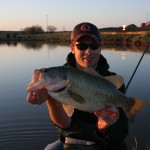By Andrew Ragas
There comes a time when the seasonal spring power and reactionary strike of a lipless crankbait fails to produce largemouth bass. An ideal alternative spring fish catching option in recent years is the compact soft plastic swimbait. In my opinion, it might be the better spring option.
It was a typical early May morning in Wisconsin’s northwoods. Air temperatures were in the high 40’s, water temperatures not much greater and windless with the skies lacking cloud cover. Despite this coldfront and within a week following ice out, sunlight penetration was warming the water temperatures, making the bass on my home lake less sluggish. As I was casting my way down the lake’s deepest sun exposed shoreline, my soft plastic swimbait was engulfed by a bass in mid-retrieve. As I set the hook with a Bill Dance accent, a four pounder erupted from the water and made its way to my landing hand. A few years later, catching largemouth bass of this caliber on compact soft plastic swimbaits has become a common scene for me each spring season wherever I fish.

Over the last 15 years, swimbaits have gained fame and some tournament anglers applying their novel techniques have earned a fortune. In this same 15 year span, swimbaits have accounted for the largest bass caught in angling history, more than any other lure type. Popularized and revolutionized in the Western United States where some of the biggest bass in the world reside, these oversized lures taken from the pages of musky and other big game fishing during the 1980’s and 90’s, have spawned into modern downsized variations which anglers are applying to bass fisheries in different areas of the country.
The idea of catching big bass is exciting. Here in the upper Midwest, oversized baits aren’t required on most waterbodies. Swimbait success isn’t confined to places where big bass roam. Each spring season from ice out through pre-spawn, I enjoy success casting with 3 and 4 inch Storm WildEye Live Shiners, and a variety of 4 inch soft plastic hollow belly and solid body swimbaits with paddle tails that can be burned and retrieved in a variety of swimming techniques. The revelation that downsized swimbaits catch quality bass everywhere won’t surprise Western anglers who popularized this angling concept. However, it greatly surprises those who live and die by the classic lipless crankbait each spring.
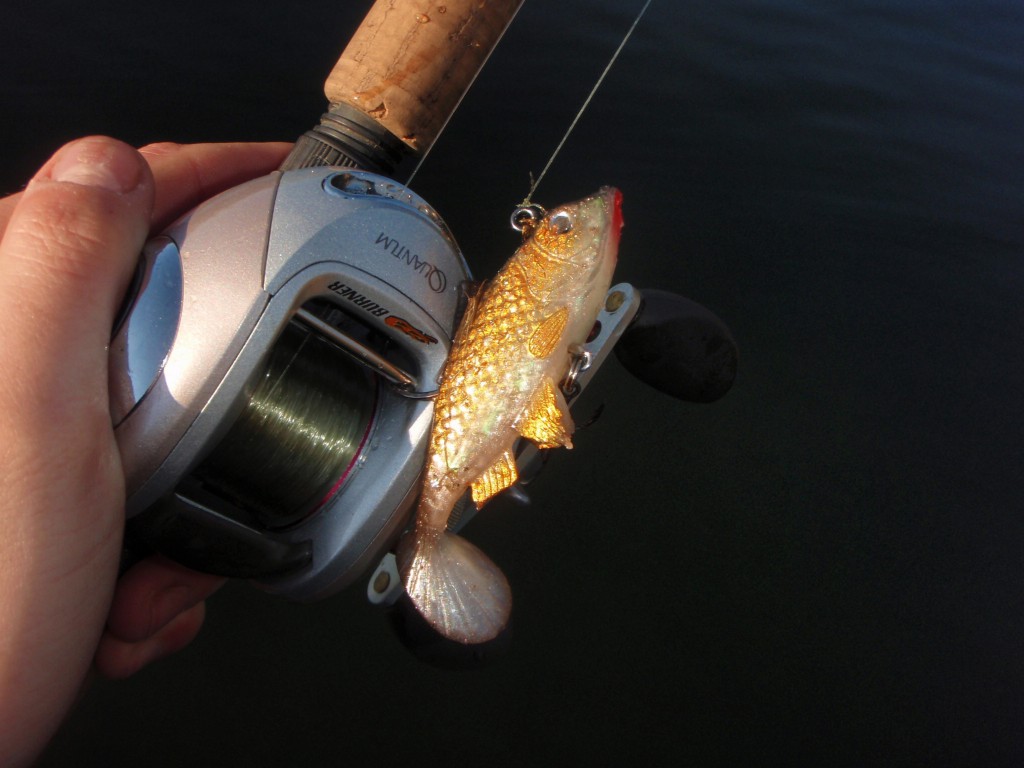
When, Where, Everywhere
Wherever you cast for springtime largemouth bass, this lure style can increase your catch rates and has the potential of quickly becoming a go-to lure. The success of compact soft plastic swimbaits has been best exemplified on 45 to 60 degree waters where bass feed, from ice-out and lasting throughout pre-spawn. When the seasonal compact reaction baits of spring don’t work, soft swimbaits are the ideal substitute.
Unlike the summer and fall periods when swimbaits are most often associated with open water schools of baitfish and deep suspended bass, swimbaits in spring are downsized presentations that are always based on precise shallow water locations and oriented with cover that’s as shallow as mere inches and as deep as 10 feet. This is why the technique works so well. On my natural lakes of the north, they catch more trophy bass for me than any other early spring technique. Additionally, throughout the years it’s been well documented that pond fishing is my biggest weakness as a bass angler. On these small waterways that populate every region and county of Illinois, compact swimbaits have resulted in my largest bass caught from the state.
These soft early spring substitutes work exceptionally well for me. So well, that a few seasons ago I converted my friends into believers in them. During my university days, I often visited my group of friends attending school in Central Illinois. They were the ones to have first crack at early season bass fishing on their local ponds so it only made sense, regardless of my inabilities to fish them. Every March and April, they lived and died by the lipless crankbait and its abilities to quickly cover every pond and hop over to the next. Although they annually caught bass weighing up to 7 pounds from these waters, there were certain days in which the lipless crankbait failed to produce a single fish. On one of my early spring weekend trips in 2010, we experienced the futility of a nonexistent lipless bite. Unlike my friends however, I did not die by it. Moments after tying on a Storm WildEye Live Shiner, a pair of 6 pounders were nearly caught from the same identical areas that were pounded by the lipless crankbait minutes before. The soft swimbait is an early spring savior.
In spring, weather and conditions of your waters play an integral role in swimbait success. The most ideal conditions for me have always been early mornings, windless days, postfrontal, and bluebird skies. For water conditions, the clearer the water the better. Clear water is optimal because swimbaits contain a combination of appealing visual elements and reactionary properties. On these waters, bass can see better for long distance and oftentimes follow the lure a great distance before eventually striking it.
These ideal conditions may be extreme to most anglers, but I feel these baits have the necessary design properties and characteristics to trigger strikes from bass as well as any aggressive reactionary hardbait can; and sometimes better.

What Makes Small and Compact Work
In a Midwest spring, there is a distinct situation that calls for soft swimbaits. Warming waters draw huge colonies of bluegills and schools of baitfish into shallow environments. When these preyfish are congregating, you can count on big bass roaming nearby. You might not see them on your electronics, or in the water below, but they’re there – often tucked into vegetation, next to cover, or staging deeper than the bluegills and baitfish. When I see these schooling fish, I cast from various angles towards every cover object, and swim it across its face. If a big bass is around, you can usually get her to commit on these soft compact plastics.
Downsized baits have less weight, allowing them to be fished through shallow water environments. There are several key design factors leading to the swimbait’s success in shallow water. First and foremost, their downsized compact sizes are similar representations of a lipless crankbait in terms of shape and physical features. Storm WildEye Live Shads, for example, are molded over a stand-up jig weight system and follow the design concept of lipless hardbaits. A second key factor is the paddle tail and its side-to-side wobbling action during retrieve. The amount of vibration emitted by the swimbait is entirely dependant on speed of retrieve and weight of the paddle tail. Think of the tail imitating the bait’s rattle system which is the triggering factor behind lipless crankbaits. The bulkier the tail segment and its paddling action, the greater vibration the bait gives off, leading way to reactionary strikes. Most swimbaits represent identical swimming movements and behaviors of fleeing baitfish and preyfish. The best soft swimbaits are those that can be retrieved in varying speeds and are tuned to run more info
straight through the selected water column.
On many natural lakes and ponds (yes, I said ponds), I like to fish compact swimbaits quickly. For casting quickly over emerging weedgrowth and burning through the shallows, I like working 3 to 4 in models of most brands that have downsized models available. The advantage of fishing small swimbaits is bigger bass tend to be selective on shape and color. Downsized presentations seem to eliminate that behavior in spring. Another is improved hook sets. Your hook set ratio rises from about 50 percent with large oversized baits to about 90 percent with these compact baits. Most hollow belly and soft bodied swimbaits allow their hook systems to penetrate bass jaws easier than other bigger soft bodied swimbaits.

Spring Swimbait Styles
While no fishing industry definition for the word “swimbait” exists, I suggest that the lure category includes baits that not only produce a wiggling tail action, but move and vibrate in the manner of a crankbait. While some swimbaits have lips and diving features, others produce action through their shape of plastic and combination of weight whether it’s by jig, weighted hook system, or interior mold. The swimbaits I choose to fish with during the spring season are at the miniature end of the size spectrum, and range in sizes from a minimum of 2 inches to a maximum of 5 inches in length.
To date, I’ve had my best swimbait success with Storm Lures. My all time favorite for this spring technique, the WildEye Live Shiner, is an internally weighted lifelike swimming bait available in 2-, 3- and 4-inch models. With the soft outer body molded over a 3/8 ounce weighted inner body, an incredibly lifelike swimming action results. For improved hooking percentages, I recommend removing its VMC treble hooks located on the belly and replacing them in favor of Eagle Claw Trokar’s TK300 round bend treble hooks in sizes 4 or 5.
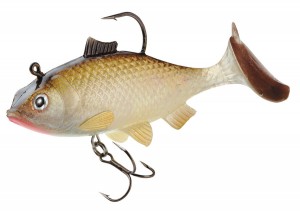
In a separate class of its own, the YUM Money Minnow is a great versatile hollow belly option. At lengths of 2.5, 3.5 and 5 inches, it offers bass a longer, more streamlined presentation that minimizes weight and increases buoyancy. For recreational and tournament anglers, it’s becoming a serious go-to bait that can be fished through heavy cover, over grass beds, and deeper water. Tapering from a broad head section down to a thin tail section emitting a pumping side-to-side wiggle, the Money Minnow features a natural swimming action that garners attention from hesitant bass. Rigged with a weighted extra wide gap swimbait hook, it’s a weedless paddletail swimbait that’s more than capable of matching nearly every bass fishing situation and prey imitation.
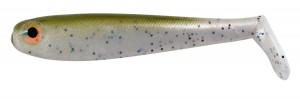
Lighter swimbaits are better for slow-rolling or stop-and-go retrieves from the surface down to 5 feet or so. Some new swimbaits fitting this mold are the Swimz and Swankx, manufactured by Stankx Bait Company from Kalamazoo, Michigan. Introduced in spring 2013, I’ve had the pleasure of fishing with these solid body swimbaits for less than a year now. Both are available in 4.5 inch models featuring hook slot and solid body options, and are manufactured with durable medium plastic blends that maximize fluttering and tail kicking action. Where the two products differ greatly is in the tail action. The 4.5” Swimz is molded with a deeper belly and slender tail segment, allowing it to be fished deeper and slower. Meanwhile, the 4.5” Swimz is more compact and solid from head to tail, and serves best when speed fishing and burning the shallows is necessary. Both can be fished with weighted jigs, or specialty swimbait hooks which is my preferred method. One other feature making Stankx swimbaits special is its custom color options and competitive pricing. Travis Crosman is more than capable of matching the hatch for any preyfish prevalent in spring. He now offers airbrushed swimbait color patterns called the NXT LVL Series, available in 20 different colorways, making them the most lifelike and detailed custom soft plastics on the bass angling market today.
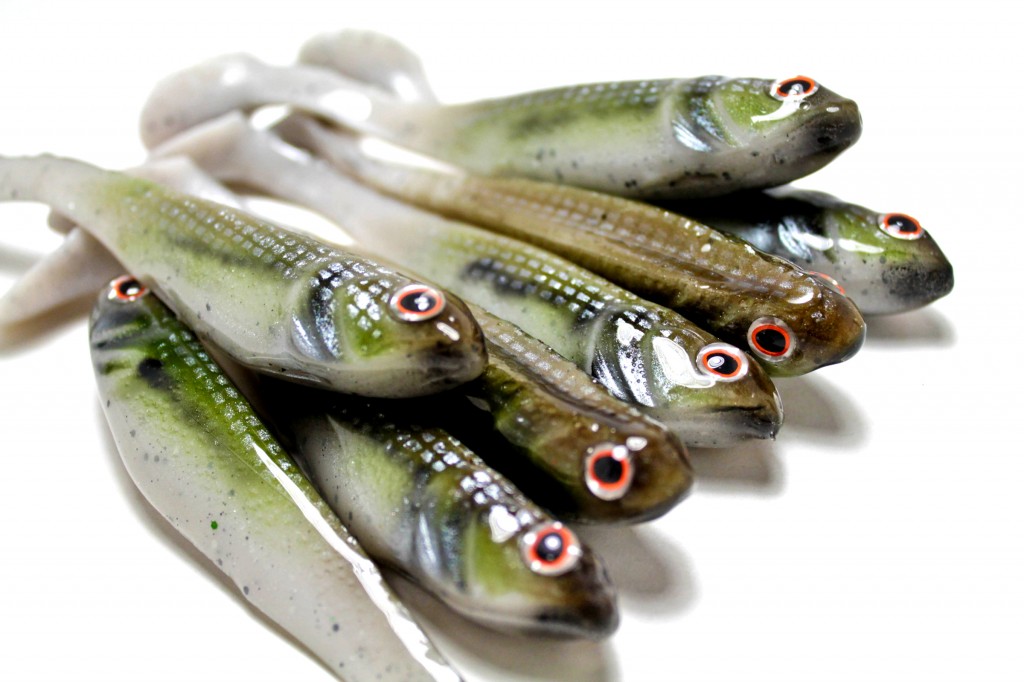
When rigging these soft plastics with swimbait hooks, look into Eagle Claw Trokar’s magnum weighted swimbait hooks in both 3/0 (1/8 oz) or 5/0 (1/4 oz) sizes. A secondary swimbait rigging option I’ve also enjoyed using is Freedom Tackle Corporation’s Stealth and Hydra jigs. Their interchangeable jig head system allows bass anglers to cater hook size and type to the length and style of plastics being fished. Rigged with Eagle Claw Trokar’s magworm hooks, the Stealth and Hydra heads allow a deeper swimbait presentation and promote a natural, unrestricted swimming action that isn’t affected by a connecting jig head
Techniques and Tackle
Long casting swimbaits is the most popular approach, though quick fan casting is the most thorough strategy for shallow water fishing. Anglers should concentrate on presenting the baits naturally on ambush spots which may include underwater points, primary drop-offs, floating vegetation, bogs, lilly pad lanes, laydowns, emerging weedgrowth, and boat docks. Always consider the shape of the structure or cover and the direction you want to retrieve the bait. Understanding your casting angles and the direction from which you approach fish and trigger bites is critical to the success of this style of fishing as is deciphering what the fish are telling you. In any style of retrieve, you never want your lure to hit bottom. The name of this game is to always keep it moving through shallow cover.
For these downsized swimbaits, tackle selection depends entirely on the style and size of swimbaits being fished, and to an extent, personal preference. Because this involves power fishing and quick retrieves, reels with a 7:0 gear ratio or greater are most ideal. I prefer fishing with a 7.3:1 Quantum Energy SS which allows a whopping 34 inches per turn. The rod should have a medium action tip, allowing a bass to inhale the bait. A 7 foot medium heavy fast action baitcasting outfit spooled with 12 to 17 pound copolymer is ideal for most situations around vegetation and minimal brush. Fluorocarbon in the same diameter also excels for running swimbaits deeper, and allows more powerful hooksets due to reduced stretch. Lures that are larger in size and weight, and thicker cover require heavier set-ups. In these situations, use a heavy action rod with softer than normal tip to prevent tearing hooks loose from fish. Braided superline such as 30lb Cortland Masterbraid will minimize missed fish, detect strikes, and allow you to swim and rip your weedless swimbait rigs through dense shallow cover and its openings.
Downsized swimbaits represent a new, overlooked way of catching bass. It’s also a potent presentation that has not yet been exploited by the masses to catching largemouth bass during the early spring season. It’s a lure style possessing its own unique role, and is the lone ranger within the swimming soft plastics category. The select baits described and highlighted represent some of the best options for downsizing during the spring season, and give bass anglers an ideal early spring alternative when more seasonal power fishing techniques fail.






